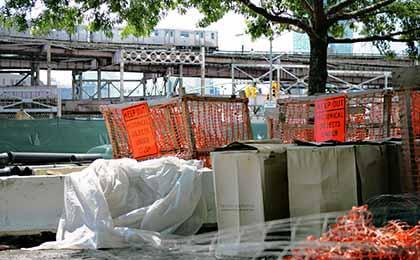By Nathan Duke
An effort to preserve a pair of Long Island City millstones from the 17th century has split western Queens community activists who are debating where the artifacts should be stored even as the city plans to relocate them to a neighborhood library.
The millstones were constructed by the Dutch more than 450 years ago as part of a large tile mill in Long Island City. The two stones, believed to be the oldest surviving European artifact in Queens, are currently being held at a construction site within the massive Queens Plaza redevelopment project.
But leaders of the Dutch Kills Civic Association and the Greater Astoria Historical Society have clashed on where the millstones should be placed until they can be returned to their original site upon Queens Plaza’s completion.
Against this backdrop, the Department of City Planning intends to move the stones from Queens Plaza to the Queens Library’s Long Island City branch on 21st Street for storage at an undisclosed time.
“We’re being rolled over,” Dutch Kills resident Megan Friedman said of the city’s plan. “We’re not being included in the discussion. It’s flabbergasting. There’s total neglect.”
Friedman supports the historical society’s plan to place the stones in its exhibit space on Broadway in Astoria.
Bob Singleton, the historical society’s president, said some community members view City Planning’s decision to eventually move the stones to the library as another example of the city steamrolling over the interests of the neighborhood.
He cited the city’s delay in implementing a 2005 plan to rezone Dutch Kills, which enabled a number of hotels to obtain permits to build in western Queens.
“People think it’s another step in a series of donnybrooks within the community, from the hotels to the way the rezoning was handled by the Economic Development Corp. and elected officials,” he said. “It’s the straw that broke the camel’s back. These stones have been in our community for years. The historical society has suggested a safe haven, such as our site, where they can be kept.”
Singleton said many Dutch Kills residents do not support the idea of placing the stones in the library.
“The community was first told that the stones were fragile, but now the EDC is saying they are robust and will be transferred from Queens Plaza to the library,” he said. “That was a bombshell to the community.”
The city EDC, which is handling the Queens Plaza project, told community leaders it would hire a preservation consultant to keep an eye on the stones.
But leaders of the Dutch Kills Civic Association, which is working with City Planning on moving the stones to the library, vowed that the historical society would not determine the holding place for the artifacts.
“Mr. Singleton is nothing more than an interloper,” said civic member George Stamatiades. “He has not taken an interest in the stones for 20 years. Now he wants to be the great white knight. The plan for the stones is to go to the library, where they can be studied by children. It’s safe and secure. I view this as an attempt for Mr. Singleton to steal our history and he’s not going to do it at the expense of the community.”
Stamatiades said the stones are currently encased in plywood boxes with barriers and locked behind a 10-foot gate at Queens Plaza. One of the stones was removed from the ground in the presence of a preservation specialist, he said.
Reshma Saujani, a Manhattan attorney who is challenging U.S. Rep. Carolyn Maloney (D-Astoria) for her seat, said the millstones have suffered from years of “abuse.”
“The residents of Dutch Kills have voiced their concerns about the future of the historic millstones that have suffered years of abuse and neglect,” she said. “The city’s decisions about moving the millstones have been made in backroom dealings instead of in open public forums.”
Saujani said she would like to see the Greater Astoria Historical Society care for the stones.
The stones, which are more than 6 feet in diameter and weigh at least 400 pounds, were used as part of the tile mill’s operation to grind wheat into flour. But the mill was closed down in the 1820s and the site was then owned by a family of farmers before Queens Plaza was created in 1909.
The Queens Plaza project includes street repaving and the creation of a new common area.
Reach reporter Nathan Duke by e-mail at nduke@cnglocal.com or by phone at 718-260-4566.
































